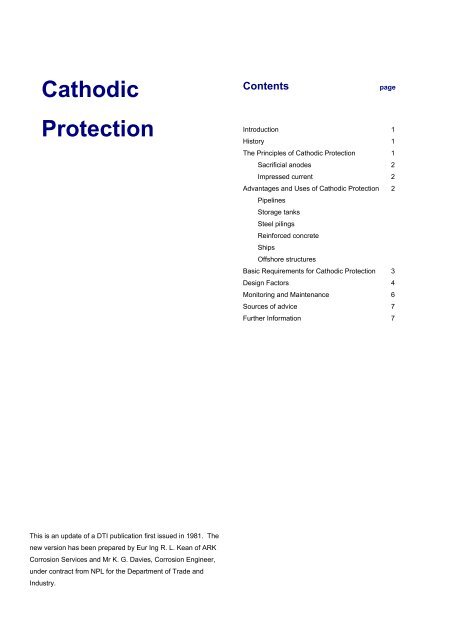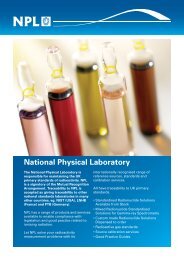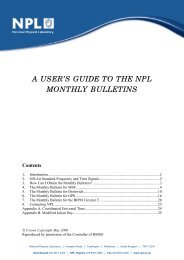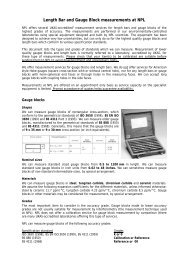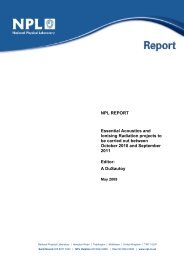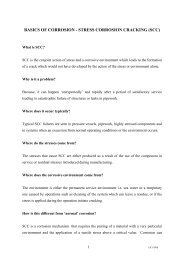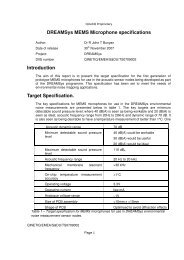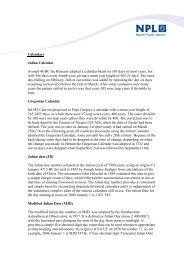Cathodic Protection - National Physical Laboratory
Cathodic Protection - National Physical Laboratory
Cathodic Protection - National Physical Laboratory
Create successful ePaper yourself
Turn your PDF publications into a flip-book with our unique Google optimized e-Paper software.
<strong>Cathodic</strong><br />
Contents<br />
page<br />
<strong>Protection</strong><br />
Introduction 1<br />
History 1<br />
The Principles of <strong>Cathodic</strong> <strong>Protection</strong> 1<br />
Sacrificial anodes 2<br />
Impressed current 2<br />
Advantages and Uses of <strong>Cathodic</strong> <strong>Protection</strong> 2<br />
Pipelines<br />
Storage tanks<br />
Steel pilings<br />
Reinforced concrete<br />
Ships<br />
Offshore structures<br />
Basic Requirements for <strong>Cathodic</strong> <strong>Protection</strong> 3<br />
Design Factors 4<br />
Monitoring and Maintenance 6<br />
Sources of advice 7<br />
Further Information 7<br />
This is an update of a DTI publication first issued in 1981. The<br />
new version has been prepared by Eur Ing R. L. Kean of ARK<br />
Corrosion Services and Mr K. G. Davies, Corrosion Engineer,<br />
under contract from NPL for the Department of Trade and<br />
Industry.
<strong>Cathodic</strong> <strong>Protection</strong><br />
1.0 Introduction<br />
This Guide describes the basic principles of cathodic protection,<br />
the areas of use, and the general factors to be considered in the<br />
choice and design of a system. It gives a basic introduction and<br />
simple technical data on cathodic protection. Further assistance<br />
and information may be gained from organisations listed in<br />
Section 10, various independent or commercial consultants, and<br />
product suppliers.<br />
2.0 History<br />
The first reported practical use of cathodic protection is<br />
generally credited to Sir Humphrey Davy in the 1820s. Davy’s<br />
advice was sought by the Royal Navy in investigating the<br />
corrosion of copper sheeting used for cladding the hulls of naval<br />
vessels. Davy found that he could preserve copper in seawater<br />
by the attachment of small quantities of iron, zinc or tin. The<br />
copper became, as Davy put it, “cathodically protected”. It was<br />
quickly abandoned because by protecting the copper its antifouling<br />
properties became retarded, hence reducing the<br />
streamline of the ships, as they began to collect marine growths.<br />
The most rapid development of cathodic-protection was made in<br />
the United States of America and by 1945, the method was well<br />
established to meet the requirements of the rapidly expanding<br />
oil and natural gas industry, which wanted to benefit from the<br />
advantages of using thin-walled steel pipes for underground<br />
transmission.<br />
In the United Kingdom, where low-pressure, thicker-walled castiron<br />
pipes were used extensively, very little cathodic protection<br />
was applied until the early 1950s. The increasing use of<br />
cathodic protection in modern times has arisen, in part, from the<br />
initial success of the method as used from 1952 onwards to<br />
protect about 1000 miles of wartime fuel-line network. The<br />
method is now well established and is used on a wide variety of<br />
immersed and buried facilities and infrastructure, as well as<br />
reinforced concrete structures, to provide corrosion control.<br />
3.0 The Principles of <strong>Cathodic</strong> <strong>Protection</strong><br />
Metal that has been extracted from its primary ore (metal oxides<br />
or other free radicals) has a natural tendency to revert to that<br />
state under the action of oxygen and water. This action is called<br />
corrosion and the most common example is the rusting of steel.<br />
Corrosion is an electro-chemical process that involves the<br />
passage of electrical currents on a micro or macro scale. The<br />
change from the metallic to the combined form occurs by an<br />
“anodic” reaction:<br />
M → M + + e -<br />
(metal) (soluble salt) (electron)<br />
A common example is:<br />
Fe → Fe ++ + 2e -<br />
This reaction produces free electrons, which pass within the<br />
metal to another site on the metal surface (the cathode), where<br />
it is consumed by the cathodic reaction. In acid solutions the<br />
cathodic reaction is:<br />
2H + + 2e - → H 2<br />
(hydrogen ions<br />
(gas)<br />
in solution)<br />
In neutral solutions the cathodic reaction involves the<br />
consumption of oxygen dissolved in the solution:<br />
O 2 + 2H 2 O + 4e - → 4OH -<br />
(alkali)<br />
Corrosion thus occurs at the anode but not at the cathode<br />
(unless the metal of the cathode is attacked by alkali).<br />
2M → 2M ++ + 4e -<br />
O 2 + 2H 2 O + 4e - → 4OH -<br />
(corrosion)<br />
Electron (e - ) flow in metal<br />
Figure 1. Corrosion cell / Bimetallic corrosion<br />
The anode and cathode in a corrosion process may be on two<br />
different metals connected together forming a bimetallic couple,<br />
or, as with rusting of steel, they may be close together on the<br />
same metal surface.<br />
This corrosion process is initially caused by:<br />
Differerence in natural potential in galvanic (bimetallic) couples.<br />
Metallurgical variations in the state of the metal at different<br />
points on the surface.<br />
Local differences in the environment, such as variations in the<br />
supply of oxygen at the surface (oxygen rich areas become the<br />
cathode and oxygen depleted areas become the anode).<br />
1 1
<strong>Cathodic</strong> <strong>Protection</strong><br />
The principle of cathodic protection is in connecting an external<br />
anode to the metal to be protected and the passing of an<br />
electrical dc current so that all areas of the metal surface<br />
become cathodic and therefore do not corrode. The external<br />
anode may be a galvanic anode, where the current is a result of<br />
the potential difference between the two metals, or it may be an<br />
impressed current anode, where the current is impressed from<br />
an external dc power source. In electro-chemical terms, the<br />
electrical potential between the metal and the electrolyte<br />
solution with which it is in contact is made more negative, by the<br />
supply of negative charged electrons, to a value at which the<br />
corroding (anodic) reactions are stifled and only cathodic<br />
reactions can take place. In the discussion that follows it is<br />
assumed that the metal to be protected is carbon steel, which is<br />
the most common material used in construction. The cathodic<br />
protection of reinforcing carbon steel in reinforced concrete<br />
structures can be applied in a similar manner.<br />
<strong>Cathodic</strong> protection can be achieved in two ways:<br />
- by the use of galvanic (sacrificial) anodes, or<br />
- by “impressed” current.<br />
Galvanic anode systems employ reactive metals as auxiliary<br />
anodes that are directly electrically connected to the steel to be<br />
protected. The difference in natural potentials between the<br />
anode and the steel, as indicated by their relative positions in<br />
the electro-chemical series, causes a positive current to flow in<br />
the electrolyte, from the anode to the steel. Thus, the whole<br />
surface of the steel becomes more negatively charged and<br />
becomes the cathode. The metals commonly used, as<br />
sacrificial anodes are aluminium, zinc and magnesium. These<br />
metals are alloyed to improve the long-term performance and<br />
dissolution characteristics.<br />
Impressed-current systems employ inert (zero or low<br />
dissolution) anodes and use an external source of dc power<br />
(rectified ac) to impress a current from an external anode onto<br />
the cathode surface.<br />
The connections are similar for the application of cathodic<br />
protection to metallic storage tanks, jetties, offshore structures<br />
and reinforced concrete structures.<br />
4.0 Advantages and Uses of <strong>Cathodic</strong><br />
<strong>Protection</strong><br />
The main advantage of cathodic protection over other forms of<br />
anti-corrosion treatment is that it is applied simply by<br />
maintaining a dc circuit and its effectiveness may be monitored<br />
continuously. <strong>Cathodic</strong> protection is commonly applied to a<br />
coated structure to provide corrosion control to areas where the<br />
coating may be damaged. It may be applied to existing<br />
structures to prolong their life.<br />
Specifying the use of cathodic protection initially will avoid the<br />
need to provide a “corrosion allowance” to thin sections of<br />
structures that may be costly to fabricate. It may be used to<br />
afford security where even a small leak cannot be tolerated for<br />
reasons of safety or environment. <strong>Cathodic</strong> protection can, in<br />
principle, be applied to any metallic structure in contact with a<br />
bulk electrolyte (including concrete). In practice, its main use is<br />
to protect steel structures buried in soil or immersed in water. It<br />
cannot be used to prevent atmospheric corrosion on metals.<br />
However, it can be used to protect atmospherically exposed<br />
and buried reinforced concrete from corrosion, as the concrete<br />
itself contains sufficient moisture to act as the electrolyte.<br />
Structures that are commonly protected by cathodic protection<br />
are the exterior surfaces of:<br />
Pipelines<br />
Ships’ hulls<br />
Storage tank bases<br />
Jetties and harbour structures<br />
Steel sheet, tubular and foundation pilings<br />
Offshore platforms, floating and sub sea structures<br />
<strong>Cathodic</strong> protection is also used to protect the internal surfaces<br />
of:<br />
Large diameter pipelines<br />
Ship’s tanks (product and ballast)<br />
Storage tanks (oil and water)<br />
Water-circulating systems.<br />
However, since an internal anode will seldom spread the<br />
protection for a distance of more than two to five pipediameters,<br />
the method is not usually practical, or suitable, for<br />
the protection of small-bore pipework.<br />
2 2
<strong>Cathodic</strong> <strong>Protection</strong><br />
<strong>Cathodic</strong> protection is applied to control the corrosion of steel<br />
embedded in reinforced concrete structures (bridges, buildings,<br />
port and harbour structures, etc.) – See Guide in Corrosion<br />
Control, Corrosion and <strong>Protection</strong> of Steel in Concrete and it’s<br />
Monitoring.<br />
<strong>Cathodic</strong> protection can be applied to copper-based alloys in<br />
water systems, and, exceptionally, to lead-sheathed cables and<br />
to aluminium alloys, where cathodic potentials have to be very<br />
carefully controlled.<br />
5.0 Basic Requirements for<br />
<strong>Cathodic</strong> <strong>Protection</strong><br />
The essential features of cathodic protection to metals that are<br />
surrounded by a conducting electrolyte, in each of the two types<br />
of system are as follows:<br />
a) A galvanic system requires:<br />
i) Sacrificial anodes<br />
ii) Direct welding to the structure or a conductor<br />
connecting the anode to the structure<br />
iii) Secure and minimum resistance connections<br />
between conductor and structure, and between<br />
conductor and anode.<br />
b) An impressed-current system requires:<br />
i) Inert anodes (clusters of which, connected together<br />
often in a backfill, are called the “groundbed”).<br />
ii) A dc power source.<br />
iii) Electrically well insulated, minimum resistance and<br />
secure conductors between anodes and power<br />
source.<br />
iv) Secure and minimum resistance connections<br />
between power source and structure.<br />
In both cases, fundamental design decisions must be made to<br />
select the type of system and the most suitable type of anode<br />
appropriate to that system. Also required, is the determination<br />
of the size and number of the power sources, or sacrificial<br />
anodes, and their distribution on the structure.<br />
Other requirements that must be met to ensure that cathodic<br />
protection is applied in the most economic and reliable manner<br />
are:<br />
a) Electrical continuity. The resistance of the conductor and<br />
structure should be such as to minimise the potential drop<br />
of the return protective currents through the structure.<br />
b) Coatings. The provision of a protective/insulating coating<br />
to the structure will greatly reduce the current demanded<br />
for cathodic protection of the metallic surface. The use of a<br />
well-applied and suitable coating, increases the effective<br />
spread of cathodic protection current. A combination of<br />
applying both a coating and cathodic protection will<br />
normally result in the most practical and economic overall<br />
protection system. Ideal coatings are those that have a<br />
high electrical resistance, are continuous and will adhere<br />
strongly to the surface to be protected. Other desirable<br />
coating characteristics include; stability in the environment,<br />
abrasion resistance, and compatibility with the alkaline<br />
environment created or enhanced by cathodic protection.<br />
c) Structure isolation. It is often desirable to limit the spread<br />
of cathodic protection. For pipelines and tanks, this may be<br />
achieved by the insertion of monolithic electrical isolation<br />
joints in the structure. Insulating flange kits are sometimes<br />
used though they often require regular maintenance.<br />
Polarisation cells that restrict low voltage cathodic<br />
protection dc currents, but allow passage of high voltage ac<br />
currents, may be used to isolate low-resistance earthing<br />
systems from a well-coated protected structure.<br />
d) Test facilities. It is important to consider the location of test<br />
facilities, test stations, corrosion monitoring coupons,<br />
permanent half cells (reference electrodes), and the<br />
manner that data can be routinely collected or viewed.<br />
6.0 Design Factors<br />
6.1 Initial considerations<br />
Modifications to the structure to incorporate requirements, such<br />
as those discussed in section 5, are best made at the early<br />
design and pre-construction phase of the structure. For<br />
underground structures it may be necessary to visit the<br />
proposed site, or for pipelines the proposed route, to obtain<br />
additional information on low-resistivity areas, availability of<br />
electric power, and the existence of stray dc current or other<br />
possible interaction.<br />
3 3
<strong>Cathodic</strong> <strong>Protection</strong><br />
It is common practice for a survey to be made before design.<br />
This survey is often combined with a study to establish<br />
economic justification for the recommended anti-corrosion<br />
proposal while the principal data necessary for design (chemical<br />
and physical) are also collected.<br />
If the structure already exists, measurement of existing<br />
structure-to-soil potentials is essential to give valuable<br />
information as to which areas are anodic and which are<br />
cathodic. In addition, with the application to the structure of<br />
temporary cathodic-protection current, using any convenient dc<br />
source and a temporary anode system (groundbed), a more<br />
accurate assessment of current demand and the likely spread of<br />
protection to the structure may be assessed.<br />
Design of a cathodic-protection system for a new structure<br />
should include the calculation of:<br />
Current demand<br />
Resistance to earth of the anodes<br />
Quantity and location of anodes or anode systems<br />
Electrical supply requirements<br />
Test and monitoring facilities.<br />
Project specifications and European or national guideline<br />
documents should be consulted.<br />
In the case of onshore pipelines and other structures,<br />
negotiation with landowners, public authorities, or other<br />
interested parties, for easements and wayleaves for<br />
groundbeds, cable routes, transformer-rectifier sites, and<br />
electricity supplies should also be undertaken at the design<br />
stage.<br />
6.2 Potential level and distribution<br />
In practice, the structure-to-electrolyte potentials are measured<br />
using a standard half-cell (reference electrode). For example, a<br />
common protection criterion used for steel in an aerobic<br />
electrolyte of nearly neutral pH is a negative value of minus 850<br />
mV. When exposed to sulphate-reducing bacteria, steel would<br />
require a more negative potential of minus 950 mV. Both values<br />
are with respect to a copper/copper sulphate half-cell. Ideally, to<br />
attain a high degree of accuracy and in order to minimise<br />
measurement errors, the half-cell should be very close to the<br />
surface at which the potential is being measured.<br />
The potential values measured on a cathodically protected<br />
structure will be dependent on the anodic and cathodic<br />
reactions, structural geometry, and internal electrical<br />
resistance. However, the provision of a protective coating will<br />
have by far the greatest effect on the potential for a given<br />
applied current. The potentials will generally be most negative<br />
at a point nearest to the anode or groundbed and, for pipelines,<br />
will attenuate towards the natural corrosion potential as the<br />
distance from the anode or groundbed increases.<br />
An example of potential attenuation is that, in the case of a<br />
power-impressed system, a single cathodic-protection<br />
installation may supply cathodic protection to as much as<br />
150 km of extremely well coated pipeline, whereas for similarsizes<br />
of bare (uncoated) pipelines it may be necessary to have<br />
installations at only 2 km intervals.<br />
6.3 Economics of decisions<br />
At the design stage of a cathodic-protection scheme, a decision<br />
must be made as to whether the scheme will be a galvanic or<br />
impressed-current system. In specific circumstances, the use<br />
of both types of systems may be appropriate, but care is<br />
required to avoid interaction between them.<br />
Galvanic systems have the advantage of being –<br />
a) simple to install<br />
b) independent of a source of external electric power<br />
c) suitable for localised protection<br />
d) less liable to cause interaction on neighbouring<br />
structures.<br />
However, the current output available from the practical size<br />
and weight of galvanic anodes is relatively small and depends<br />
principally on the electrical resistivity of the electrolyte (local<br />
environment if buried / submerged / concrete). Thus, galvanic<br />
anodes of aluminium and zinc, which have similar driving emfs<br />
to steel of approximately 0.5V, are limited to use in electrolytes<br />
of less than 5 Ohm.m resistivity. The anodes are usually selfregulating<br />
because their current output is usually less than their<br />
maximum output capability and is controlled by the difference in<br />
potential between the two metals. The current from the anodes<br />
is not normally controllable; thus changes in the structure, such<br />
as the deterioration of a coating, that causes an increase in<br />
protection current demand, may necessitate the installation of<br />
further sacrificial anodes to maintain protection.<br />
4 4
<strong>Cathodic</strong> <strong>Protection</strong><br />
Impressed-current installations have the advantage of being –<br />
a) able to supply a relatively large current<br />
b) able to provide of high dc driving voltages (up to 50V).<br />
Enables it to be used in most types of electrolytes<br />
c) able to provide a flexible output that may accommodate<br />
changes in, and additions to, the structure being<br />
protected<br />
Generally, however, care must be taken in the design to<br />
minimise interaction on other structures and, if no ac supply is<br />
available, an alternative power source (solar, diesel, etc.) is<br />
required. Impressed current systems require regular<br />
maintenance and monitoring.<br />
Generally, galvanic systems have found favour for small wellcoated,<br />
low current demand, structures or for localised<br />
protection. Impressed current schemes are utilised for large<br />
complex structures, which may be of bare metal or poorly<br />
coated. However, in North Sea offshore work, it has been found<br />
cost effective to provide galvanic protection to large uncoated<br />
platforms, and similar structures, where the initial cost of coating<br />
and the cost of maintenance are very high. In addition, the<br />
galvanic anodes offer easy to install robust systems, which<br />
being independent of a power source, provide protection<br />
immediately on “float-out” of the structure.<br />
6.3 Problems to be avoided<br />
There are certain limitations to the use of cathodic protection.<br />
Excessive negative potentials can cause accelerated corrosion<br />
of lead and aluminium structures because of the alkaline<br />
environments created at the cathode. These alkaline conditions<br />
may also be detrimental to certain coating systems, and may<br />
cause loss of adhesion of the coating. Hydrogen evolution at<br />
the cathode surface may, on high-strength steels, result in<br />
hydrogen embrittlement of the steel, with subsequent loss of<br />
strength. On some high strength steels, this may lead to<br />
catastrophic failures. It may also cause disbondment of<br />
coatings; the coating would then act as an insulating shield to<br />
the cathodic-protection currents.<br />
Consideration must also be given to spark hazards created by<br />
the introduction of electric currents into a structure situated in a<br />
hazardous area. Generally sacrificial anode systems do not<br />
cause problems, as they are self-regulating and are often<br />
regarded as systems that can be ‘fit and forget’. They must,<br />
however, be inspected at periodic intervals to ensure they are<br />
capable of supplying continued protection.<br />
Any secondary structure residing in the same electrolyte may<br />
receive and discharge the cathodic protection direct current by<br />
acting as an alternative low-resistance path (interaction).<br />
Corrosion will be accelerated on the secondary structure at any<br />
point where current is discharged to the electrolyte. This<br />
phenomenon is called "stray current corrosion".<br />
Interaction may occur, for example, on a ship that is moored<br />
alongside a cathodically protected jetty, or on a pipeline or<br />
metal-sheathed cable that crosses a cathodically protected<br />
pipeline.<br />
Interaction may be minimized by careful design of the cathodic<br />
protection system. In particular, by design of a scheme to<br />
operate at the lowest possible current density and by<br />
maintaining good separation between the protected structure<br />
and the secondary structure, and between the groundbeds or<br />
anodes and the secondary structure.<br />
It is an advantage of sacrificial-anode schemes that they are<br />
not prone to creating severe interaction problems and therefore<br />
they are popular for protection in congested and complex<br />
locations.<br />
Methods and procedures are available for overcoming<br />
interaction, and testing should be carried out in the presence of<br />
interested parties, so that the choice of remedial measures may<br />
be agreed, if and when the acceptable limit of interaction is<br />
exceeded.<br />
6.4 Types of equipment<br />
Various galvanic anode alloys of magnesium, aluminium or zinc<br />
are available in a variety of block, rod or wire forms. These<br />
alloys are cast around steel inserts to enable fixing of the<br />
anode and to maintain electrical continuity and mechanical<br />
strength towards the end of the anode life. The insert may be<br />
directly welded or bolted to the structure to be protected, or<br />
anodes may be connected to the structure by means of an<br />
insulated lead, usually of copper, as for onshore and offshore<br />
pipelines.<br />
Impressed-current groundbeds in soils have traditionally<br />
consisted of high-silicon cast iron. However, mixed metal oxide<br />
(MMO) anodes are becoming increasingly popular for all<br />
environments because of their good mechanical and electrical<br />
5 5
<strong>Cathodic</strong> <strong>Protection</strong><br />
characteristics and compact size. For seawater applications<br />
and areas where chlorides are present, MMO anodes work well<br />
as do high-silicon cast iron alloyed with chromium. Other<br />
anodes consist of lead alloy and platinum formed in a thin layer<br />
on a titanium or niobium base<br />
Galvanic-anode outputs may also be monitored, as can<br />
currents in electrical bonds between structures. Tests to<br />
measure interaction are usually conducted annually where<br />
areas are at risk or after adjustments to cathodic-protection<br />
current output.<br />
There are many possible sources of dc power; the most popular<br />
is the selenium plate or silicon-diode rectifier with transformer<br />
unit in conjunction with an existing ac supply or diesel- or gasengine-driven<br />
alternator. For most applications, a constant dc<br />
voltage or constant current systems are used.<br />
In remote areas, power sources include thermo- electric<br />
generators, closed-cycle vapour turbines, and solar or wind<br />
generators. The latter two are used in conjunction with leadacid<br />
or similar storage batteries. The choice is dependent on<br />
power requirements, maintenance capabilities, and<br />
environmental conditions.<br />
Maintenance includes the mechanical maintenance of powersupply<br />
equipment and the maintenance of painted surfaces of<br />
equipment.<br />
It is good practice to inform all owners of cathodic protection<br />
systems and infrastructure in the area of influence of any new<br />
cathodic protection systems, or of significant changes to<br />
existing systems, so that the effect on these facilities may be<br />
assessed.<br />
8.0 Sources of Advice<br />
Corrosion/<strong>Cathodic</strong> <strong>Protection</strong> Consultants – Various listings.<br />
There are also automatic control units available that will adjust<br />
current output in accordance with potential changes at a half<br />
cell.<br />
7.0 Monitoring and Maintenance<br />
<strong>Cathodic</strong>-protection systems may be monitored effectively by<br />
the measurement of structure-to-electrolyte potentials, using a<br />
high input impedance voltmeter and suitable half-cell. The<br />
standard practical half-cells are copper/copper sulphate,<br />
silver/silver chloride/seawater, silver/silver chloride/ potassium<br />
chloride and zinc.<br />
Adjustments are made to the cathodic-protection current output<br />
to ensure that protective potentials are maintained at a<br />
sufficiently negative level as defined by the project specification.<br />
The level of protection in soils and water is accepted at steel<br />
potentials of minus 850 mV (wrt Cu/CuSO 4 ) or minus 800 mV<br />
(wrt Ag/AgCl/seawater).<br />
Transformer rectifier outputs may be displayed by telemetry at<br />
central control stations. Many cathodic protection systems are<br />
increasingly being controlled and monitored by remote<br />
computers and modem links. Other communication systems<br />
that enable, for example, pipe-to- soil potentials to be monitored<br />
from a helicopter or light aeroplane, are available.<br />
Institute of Corrosion<br />
Corrosion House, Vimy Court, Leighton Buzzard<br />
Bedfordshire. LU7 1FG<br />
<strong>National</strong> Association of Corrosion Engineers (NACE)<br />
International<br />
Houston, Texas, USA<br />
Institute of Materials, Minerals and Mining<br />
1 Carlton House Terrace, London. SW1Y 5DB<br />
The Institution of Civil Engineers<br />
One Great George Street, Westminster, London SW1P 3AA<br />
Corrosion <strong>Protection</strong> Association (Reinforced Concrete)<br />
Association House, 99 West Street, Farnham, Surrey GU9 7EN<br />
The Society of Operations Engineers<br />
22 Greencoat Place, London. SW1P 1PR<br />
Galvanisers Association<br />
6 Wren’s Court, 56 Victoria Road, Sutton Coldfield<br />
West Midlands B72 1SY<br />
Paint Research Association<br />
8 Waldegrave Road, Teddington, Middlesex, TW11 8LD<br />
6 6
<strong>Cathodic</strong> <strong>Protection</strong><br />
Pipeline Industries Guild<br />
14/15 Belgrave Square, London SW1X 8PS<br />
BS EN 12696 <strong>Cathodic</strong> protection of steel in concrete<br />
Part 1 : Atmospherically exposed concrete<br />
9.0 Further Information<br />
The following references provide further information on cathodic<br />
protection. Potential users are recommended to employ<br />
qualified and experienced specialists to design and undertake<br />
the work. The following handbook provides listings of various<br />
manufacturers, suppliers, consultants, and contractors.<br />
BS EN 12954 <strong>Cathodic</strong> protection of buried or immersed<br />
metallic structures – General principles and application for<br />
pipelines.<br />
BS EN 13173 <strong>Cathodic</strong> protection for steel offshore floating<br />
structures.<br />
BS EN 13174 <strong>Cathodic</strong> protection for harbour installations.<br />
The Corrosion Handbook, 1999, (incorporating Corrosion<br />
Prevention Directory), MPI Group, (Inst. of Materials, Inst. of<br />
Corrosion)<br />
Other useful Publications:<br />
J.H. Morgan '<strong>Cathodic</strong> <strong>Protection</strong>' <strong>National</strong> Association of<br />
Corrosion Engineers (NACE) 1987 2nd Edition.<br />
Peabody’s Control of Pipeline Corrosion. (2 nd edition, Ed by R<br />
Bianchetti), NACE, Houston, 2000.<br />
Corrosion and corrosion control. H H Uhlig, Wiley, New York,<br />
1985 (3rd edition).<br />
Corrosion. L L Shreir (2 vols), Newnes-Butterworth, 19 (3rd<br />
edition).<br />
<strong>Cathodic</strong> <strong>Protection</strong> Criteria - A Literature Survey' <strong>National</strong><br />
Association of Corrosion Engineers (NACE) 1989.<br />
W.V. Baeckmann 'Handbook of <strong>Cathodic</strong> Corrosion <strong>Protection</strong>',<br />
(3 rd edition) Gulf Pub., 1997.<br />
Standards<br />
BS 7361 Part 1 1991 '<strong>Cathodic</strong> <strong>Protection</strong> Part 1 - Code of<br />
Practice for Land and Marine Applications' British Standards<br />
Institution, U.K.<br />
BS EN 12473 General principles of cathodic protection in sea<br />
water.<br />
BS EN 12474 <strong>Cathodic</strong> protection for submarine pipelines.<br />
7 7


